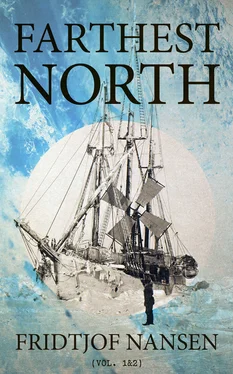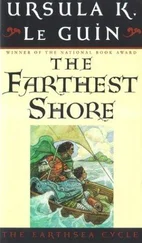“This being so, it seems to me that the plain thing for us to do is to make our way into the current on that side of the Pole where it flows northward, and by its help to penetrate into those regions which all who have hitherto worked against it have sought in vain to reach.
“My plan is, briefly, as follows: I propose to have a ship built as small and as strong as possible—just big enough to contain supplies of coals and provisions for twelve men for five years. A ship of about 170 tons (gross) will probably suffice. Its engine should be powerful enough to give a speed of 6 knots; but in addition it must also be fully rigged for sailing.
“The main point in this vessel is that it be built on such principles as to enable it to withstand the pressure of the ice. The sides must slope sufficiently to prevent the ice, when it presses together, from getting firm hold of the hull, as was the case with the Jeannette and other vessels. Instead of nipping the ship, the ice must raise it up out of the water. No very new departure in construction is likely to be needed, for the Jeannette , notwithstanding her preposterous build, was able to hold out against the ice pressure for about two years. That a vessel can easily be built on such lines as to fulfil these requirements no one will question who has seen a ship nipped by the ice. For the same reason, too, the ship ought to be a small one; for, besides being thus easier to manœuvre in the ice, it will be more readily lifted by the pressure of the ice, not to mention that it will be easier to give it the requisite strength. It must, of course, be built of picked materials. A ship of the form and size here indicated will not be a good or comfortable sea-boat, but that is of minor importance in waters filled with ice such as we are here speaking of. It is true that it would have to travel a long distance over the open sea before it would get so far, but it would not be so bad a sea-boat as to be unable to get along, even though sea-sick passengers might have to offer sacrifices to the gods of the sea.
“With such a ship and a crew of ten, or at the most twelve, able-bodied and carefully picked men, with a full equipment for five years, in every respect as good as modern appliances permit of, I am of opinion that the undertaking would be well secured against risk. With this ship we should sail up through Bering Strait and westward along the north coast of Siberia towards the New Siberian Islands 8as early in the summer as the ice would permit.
“Arrived at the New Siberian Islands, it will be advisable to employ the time to the best advantage in examining the conditions of currents and ice, and to wait for the most opportune moment to advance as far as possible in ice-free water, which, judging by the accounts of the ice conditions north of Bering Strait given by American whalers, will probably be in August or the beginning of September.
“When the right time has arrived, then we shall plough our way in amongst the ice as far as we can. We may venture to conclude from the experience of the Jeannette expedition that we should thus be able to reach a point north of the most northerly of the New Siberian Islands. De Long notes in his journal that while the expedition was drifting in the ice north of Bennett Island they saw all around them a dark ‘water-sky’—that is to say, a sky which gives a dark reflection of open water—indicating such a sea as would be, at all events, to some extent navigable by a strong ice-ship. Next, it must be borne in mind that the whole Jeannette expedition travelled in boats, partly in open water, from Bennett Island to the Siberian coast, where, as we know, the majority of them met with a lamentable end. Nordenskiöld advanced no farther northward than to the southernmost of the islands mentioned (at the end of August) but here he found the water everywhere open.
“It is, therefore, probable that we may be able to push our way up past the New Siberian Islands, and that accomplished we shall be right in the current which carried the Jeannette . The thing will then be simply to force our way northward till we are set fast. 9
“Next we must choose a fitting place and moor the ship firmly between suitable ice-floes, and then let the ice screw itself together as much as it likes—the more the better. The ship will simply be hoisted up and will ride safely and firmly. It is possible it may heel over to a certain extent under this pressure; but that will scarcely be of much importance. ... Henceforth the current will be our motive power, while our ship, no longer a means of transport, will become a barrack, and we shall have ample time for scientific observations.
“In this manner the expedition will, as above indicated, probably drift across the Pole, and onward to the sea between Greenland and Spitzbergen. And when we get down to the 80th degree of latitude, or even sooner, if it is summer, there is every likelihood of our getting the ship free and being able to sail home. Should she, however, be lost before this—which is certainly possible, though, as I think, very unlikely if she is constructed in the way above described—the expedition will not, therefore, be a failure, for our homeward course must in any case follow the polar current on to the North Atlantic basin; there is plenty of ice to drift on, and of this means of locomotion we have already had experience. If the Jeannette expedition had had sufficient provisions, and had remained on the ice-floe on which the relics were ultimately found, the result would doubtless have been very different from what it was. Our ship cannot possibly founder under the ice-pressure so quickly but that there would be time enough to remove, with all our equipment and provisions, to a substantial ice-floe, which we should have selected beforehand in view of such a contingency. Here the tents, which we should take with us to meet this contingency, would be pitched. In order to preserve our provisions and other equipments, we should not place them all together on one spot, but should distribute them over the ice, laying them on rafts of planks and beams which we should have built on it. This will obviate the possibility of any of our equipments sinking, even should the floe on which they are break up. The crew of the Hansa , who drifted for more than half a year along the east coast of Greenland, in this way lost a great quantity of their supplies.
“For the success of such an expedition two things only are required, viz., good clothing and plenty of food , and these we can take care to have with us. We should thus be able to remain as safely on our ice-floe as in our ship, and should advance just as well towards the Greenland Sea. The only difference would be that on our arrival there, instead of proceeding by ship, we must take to our boats, which would convey us just as safely to the nearest harbor.
“Thus it seems to me there is an overwhelming probability that such an expedition would be successful. Many people, however, will certainly urge: ‘In all currents there are eddies and backwaters; suppose, then, you get into one of these, or perhaps stumble on an unknown land up by the Pole and remain lying fast there, how will you extricate yourselves?’ To this I would merely reply, as concerns the backwater, that we must get out of it just as surely as we got into it, and that we shall have provisions for five years. And as regards the other possibility, we should hail such an occurrence with delight, for no spot on earth could well be found of greater scientific interest. On this newly discovered land we should make as many observations as possible. Should time wear on and find us still unable to get our ship into the set of the current again, there would be nothing for it but to abandon her, and with our boats and necessary stores to search for the nearest current, in order to drift in the manner before mentioned.
Читать дальше












